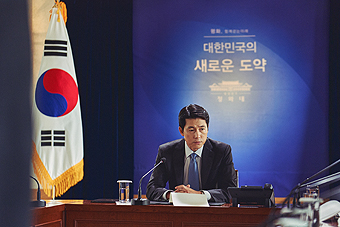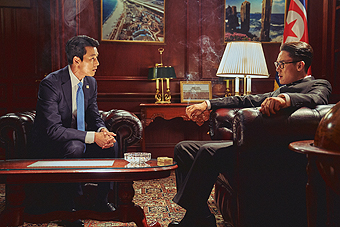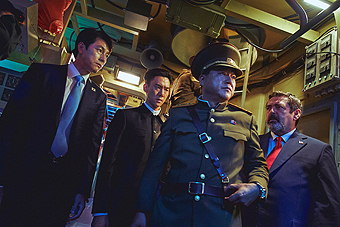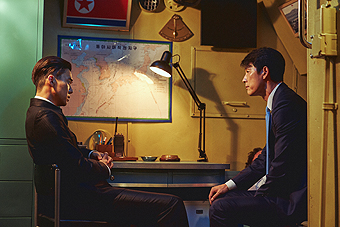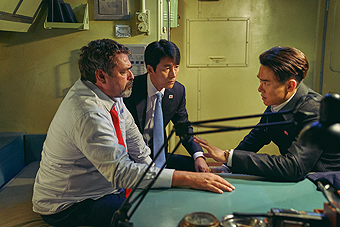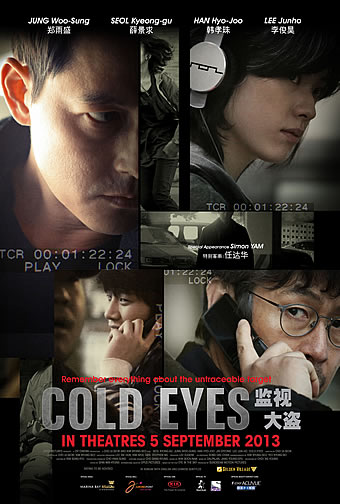STEEL RAIN: SUMMIT (강철비2: 정상회담) (2020)
Genre: Action/Thriller
Director: Yang Woo-suk
Cast: Jung Woo-sung, Kwak Do-won, Yoo Yeon-seok, Angus Macfadyen
Runtime: 2 hrs 12 mins
Rating: NC16 (Some Coarse Language)
Released By: Golden Village Pictures
Official Website:
Opening Day: 13 August 2020
Synopsis: Leaders of South Korea, North Korea, and the U.S. hold a summit in Wonsan, North Korea to discuss North Korea’s nuclear issue and peace in the Korean Peninsula. Interrupted by some North Korean hardliners who have raised a coup, the leaders of the three countries are abducted and taken away on a North Korean submarine. As the North Korean hardliners, the U.S., Japan, and China each set up their own plans for war, how will President HAN of South Korea, who is trapped inside a submarine, overcome this crisis?
Movie Review:
There is no narrative relation between ‘Steel Rain 2: Summit’ and its 2017 predecessor, even though both star Jung Woo-sung and Kwak Do-won, other than that they both deal with hardliners within the North Korean military wanting to scuttle peace efforts between North and South Korea.
In fact, Jung and Kwak have switched sides in this thematic sequel – whereas he played a loyal North Korean agent earlier, Jung is now the South Korean President Han; and while Kwak was playing a South Korean government official helping Jung’s character previously, he is now no less than the Supreme Guard commander who engineers a coup against his Supreme Leader.
Than working with each other, their characters are now working against each other. To prevent President Han from brokering a historic peace deal between his country and the United States, Kwak’s Commander Park Jin-woo sends his troops to surround the hotel in Wonsan where the leaders have gathered. Outnumbered, the three Heads of State are taken hostage on board the North Korean nuclear submarine Paektu, whereupon they discover an even bigger conspiracy involving China and Japan that could very well spark World War III.
Like the first movie, writer-director Yang Woo-suk injects a heavy dose of jingoism into the narrative, and depending on your knowledge of East Asia geopolitics, you may find the exposition intriguing or didactic. Dokdo (otherwise known as the Liancourt Rocks) plays a critical role in the story, its significance dating back to the Japanese invasion of Korea and the subsequent disputes over its sovereignty after the Korean War. The China-DPRK border plays a supporting but sizeable role too, its significance dating back to the Korean War. And last but not least, the US-China relationship is yet another pivotal actor, overshadowing almost every single one of the events of the film.
Frankly, those utterly unfamiliar with the delicate balance among China, DPRK, ROK and the US will probably find themselves lost amidst the labyrinth plotting, which arguably is a lot more complicated than the first movie. As tangled as it may be, you’ll have to give credit to Yang for even trying to weave such a dense backdrop into what could otherwise have been a straightforward political thriller, but the effort ultimately gives the movie added relevance especially in today’s geopolitical context.
The tension among the Big and Middle Powers sets the basis for the relationship among the key characters. President Han genuinely wants the DPRK Chairman Cho (Yoo Yeon-seok) to find common ground with the boorish US President, the latter clearly modelled after the current White House occupant; on the other hand, Han and Cho seem to have struck up a kinship as fellow Koreans, in obvious reference to the ambition of the current South Korean leadership. The interplay among them while locked inside a cramped room on the Paektu is surprisingly engaging, which is also credit to the chemistry among the three actors.
More so than the first movie, this sequel is a relatively talky affair, with much of its first two acts playing out as tense exchanges in confined spaces, whether on board a submarine or within the White House emergency room where the Vice-President and the rest of the Smoot administration have gathered to mount a response to their President’s kidnapping. Oh yes, those looking for some submarine-on-submarine action will have to wait till the last third, before things get heated both on board and outside the vessel with guns, missiles and decoys.
The wait is especially worth it for those starved of such underwater action since Gerard Butler’s ‘Hunter Killer’ two years ago, with Yang orchestrating some great nail-biting moments when President Han teams up with the Paektu’s second-in-command to wrestle control of the ship just as it is targeted by Japanese enemy subs. That said, those familiar with Butler’s film will find a whiff of similarity between the two movies, what with both featuring a veteran from the other side who guides the vessel through physically challenging waters while evading missile attacks from other subs.
Yet there is sufficient topical relevance to differentiate ‘Steel Rain 2: Summit’ from other similar genre outings, in particular with the mention of a successful peace deal between both Koreas, and a US President modelled to resemble the orange buffoon we like to call Trump. By refusing to simplify the complex balance of power in East Asia, Yang adds legitimacy to the proceedings, despite obviously taking some creative license for dramatic effect. Admittedly, it can get pretty dense in the set-up, but if you stick with it, you’ll find a tense, gripping tale of brinksmanship, diplomacy and politics.
Movie Rating:




(Steeped in the complex balance of power in East Asia, this tense, gripping and relevant sequel is both an intriguing geopolitical lesson and a white-knuckle thriller)
Review by Gabriel Chong
You might also like:

Movie Stills
